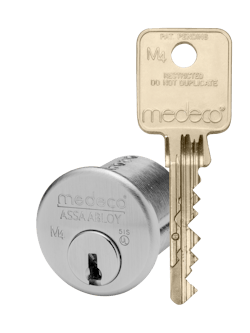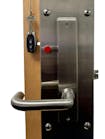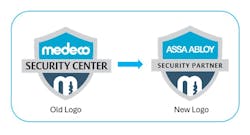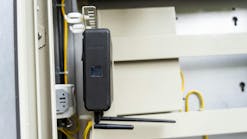Today’s high-security locking systems are much more robust than those of even just a few years ago. When installing or upgrading mechanical locks, there are five essential criteria that the system must satisfy to be considered high security.
1. It protects against unauthorized key duplication.
A locking system without a strictly controlled procedure for key duplication quickly becomes vulnerable to unauthorized access. Therefore, the first step in protecting your property and valuables is to select a utility patented key system.
With a utility patent in place, a key-control agreement is issued by the key manufacturer and signed by the locksmith and the end user. Only this particular locksmith is authorized to duplicate keys; it’s illegal for another party to produce a key that will work in a patented lock. This agreement protects all parties involved and enables legal recourse if the agreement is violated.
Of course, the law is only an effective deterrent if the individuals involved respect the law. Today’s most effective high-security locks, in addition to protecting against standard attacks, such as picking and drilling, also incorporate moving or magnetic components in the key and cylinder. This protects against more-advanced attacks, such as using keys made by 3D printers.
2. It’s certified to protect against picking, bumping and physical attacks.
The best performing high-security locking systems typically include multiple pins in a variety of locations and configurations in the cylinder, and each plays different roles in protecting against unauthorized entry. Most include a unique combination of side pins, finger pins, lift pins and other moveable components.
Underwriters Laboratories employs UL437 as the standard to assess the capability of door locks and cylinders to withstand picking, impressioning (using a blank key to take impressions of the pins in the lock) and forced-entry methods, such as drilling, prying, pulling, punching and sawing. Effective high-security locking systems carry this rating.
They also will be certified for ANSI/BHMA A156.30 for high-security cylinders (physical attack and key control) and ANSI/BHMA 156.5, which is used to establish minimum acceptable criteria for the number of cycles for cylinders and keys. The most robust high-security locking systems are designed to withstand more than 1 million cycles.
3. It provides significant masterkey capacity to accommodate large installations.
The standard masterkey system is designed with just five pins that allow only a few thousand possibilities of keying combinations. High-security key systems contain additional pins and other mechanisms in the cylinder, which facilitate thousands of extra possible key combinations. This enables the key system to include change keys, master keys, grandmaster keys, great-grandmaster keys and any additional customized keying scenarios to enable it to grow along with the organization.
4. It integrates with other existing security technologies.
Even with an effective high-security key system, one size certainly doesn’t fit all. Larger organizations require multiple levels of security, depending on the door location and what’s intended to be secured. For example, an organization’s human-resources area likely requires a more robust level of security than does its marketing department. Conference rooms containing expensive audio-visual equipment call for higher security than does a janitorial closet.
The most effective high-security key systems will integrate with existing mechanical-key systems, intelligent-key systems and high-tech access control systems. This allows users to define the level of security that’s required for each opening and thereby control costs by installing more-sophisticated high-security solutions only where necessary. Because the high-security key system integrates with existing locking systems, users continue to enjoy the convenience of carrying only one key.
5. It retrofits easily with existing hardware to avoid additional expense when upgrading.
Consider a new building that has 250 door openings. Oftentimes, building or project managers will choose to install a standard security system only to find that, a few years later, the occupant actually requires a high-security key-locking system. Is it then necessary to change out all of the existing door hardware to accommodate the new system? The answer is a resounding no. The most effective high-security system is designed by using high-security cylinders that easily retrofit with existing door hardware.
The Right Solution
If your security requirements call for a high-security locking system that not only guards against picking, bumping and physical attacks, but also discourages unauthorized key duplication, be sure to choose one that’s protected under a utility patent and managed under a key-control agreement.
In addition, to control costs, the best performing high-security locking systems easily retrofit with existing door hardware and integrate seamlessly with other security technologies. Finally, be sure the solution you choose is designed to accommodate large installations and can serve your security demands today and well into the future.
Editor’s Note: Medeco will introduce its latest high-security locking system, Medeco 4 (M4) Jan. 4, 2021. M4 provides the highest degree of protection against forced entry and physical attack. It features a patent-pending shuttle-pin movable element within its key design to prevent access using unauthorized keys — including 3D-printed keys. M4 will integrate with existing security technologies and is compatible with most hardware on the market. For more information, visit www.medeco.com/M4.
Dale L. Bowman, CML, CPP, PSP, PCI, LEED BD+C, is Medeco’s Director of Business Development, OEM and International Sales.
Dale L. Bowman
Dale L. Bowman, CML, CPP, PSP, PCI, LEED BD+C, is Medeco’s director of business development, OEM and international sales.






